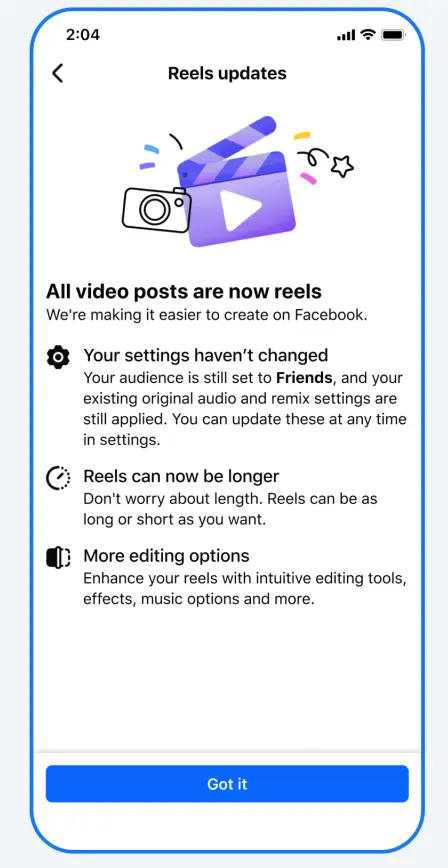- Unified Publishing Flow: Facebook merges Feed video and Reels uploads into one full-screen Reel composer, eliminating format confusion and redundant workflows.
- Enhanced Creative Toolkit: All videos—regardless of length—gain access to the same editing features (AR effects, stickers, trim controls, music), accelerating content production.
- Privacy Continuity: Users confirm or adjust their audience setting (Friends, Public, Custom) each time, ensuring consistent control across video and Reel posts.
- Tab & Analytics Alignment: The “Video” tab is renamed “Reels,” and historical metrics integrate into a unified analytics view, preserving performance insights.
- Strategic Benefits for Marketers: Brands can produce one master asset for both Feed and Reels placements, simplify ad creation, and leverage longer-form storytelling in a mobile-first environment.
Meta forces a one-flow makeover, merging Feed video and Reel uploads into an unlimited‐length, full-screen creation experience.
For years, Facebook users have toggled between two distinct workflows when posting moving images: a traditional Feed video upload for long-form content and a separate Reel composer for snappy, full-screen clips.
As of this summer, those dividing lines vanish. Meta is streamlining the process so that every new Facebook video you share—whether a 10-second behind-the-scenes snippet or a 10-minute tutorial—will be created, edited, and published through a single Reel interface.
The result? A faster, more consistent experience, no matter how you choose to tell your story.
From Dual Paths to a Single Stream
Historically, posting on Facebook demanded a choice at the outset: pick “Video” to share to your Feed with standard aspect ratios and length limits, or choose “Reel” to craft a TikTok-style, full-screen clip capped at 90 seconds.
Each format came with its own creative tools, Filters and stickers for Reels, trimming and thumbnail selection for Feed videos, forcing creators to learn and manage two separate processes.
- Complexity Today: Users often had to upload the same content twice, once as a Feed video to reach followers in the News Feed, and again as a Reel to maximize discovery in the Reels tab. Confusion and extra steps meant lost momentum and missed engagement opportunities.
- Simplicity Tomorrow: Under the new model, you open the composer, select your clip (of any length), and instantly access the full suite of editing features—everything from trimming and speed controls to AR effects and soundtracks. There’s no format toggle; the system automatically publishes your content as a Reel, optimized for both Feed and full-screen views.

Source: Meta
Why “Reels Only” Streamlines Creation
Meta’s shift isn’t just about terminology. By unifying tools and eliminating redundant options, the platform brings several immediate benefits:
- One Learning Curve: Creators and publishers—small businesses, influencers, and everyday users alike—master a single interface, reducing onboarding time and training costs.
- Faster Turnarounds: When inspiration strikes, you can capture, edit, and share without pausing to choose a publication format. That immediacy fuels real-time storytelling and keeps audiences engaged.
- Consistent Creative Toolkit: All editing features—stickers, text overlays, timed captions—are now available to every video, regardless of length or intended distribution channel.
Maintaining Control: Privacy and Reach
Switching to Reels as the default doesn’t mean losing the granular audience controls Facebook users rely on.
After uploading your clip, you’ll be prompted to confirm who sees it—Friends, specific Groups, or “Public” for maximum reach. Previously, Reel audiences defaulted to “Public” while Feed videos defaulted to “Friends,” creating potential mismatches. Now, your chosen privacy setting carries seamlessly across all posts.

Source: Meta
Moreover, channels and business pages will see their “Video” tab officially renamed “Reels,” but the underlying recommendation engine and distribution algorithms remain unchanged. Your content will still be served to viewers based on relevance and engagement signals, whether it’s a live tutorial, a meme-inspired skit, or a long-form interview.
The Rollout Roadmap
Meta plans a gradual, global rollout over the coming months, first enabling the unified Reel composer on personal profiles before extending it to Pages.
During this period, old videos and analytics won’t disappear; your existing library remains intact. Metrics for “Video” views will merge with Reel analytics in Creator Studio, giving you a holistic view of performance across formats.
Creators should look out for:
- Composer Update: A new “Create Reel” button replaces both “Post Video” and “Create Reel.”
- Reels Tab Relabel: The familiar “Video” tab on your profile or Page switches to “Reels,” but retains long-form and short-form content together.
- Help Center Guides: In-app prompts and support articles will walk you through confirming privacy settings and accessing the enhanced editing suite.
Implications for Marketers and Content Strategists
For brands and agencies, the change simplifies planning and production.
Campaigns no longer require separate deliverables for Feed vs. Reels. Instead, one master asset, edited once, can serve both goals—drive awareness in the News Feed and spark discovery in Reels.
Paid social managers will appreciate streamlined ad creation flows, as the same Reel can be promoted across both placements without repackaging.
Additionally, the removal of length restrictions on Reels (beyond Instagram’s 15-minute cap) opens the door for episodic storytelling and deeper educational series directly within Facebook’s mobile experience. This capacity is especially valuable for product demos, webinars, and behind-the-scenes content that previously felt squeezed into shorter formats.
Embracing the Reel-First Future
Meta’s decision to make every Facebook video a Reel isn’t merely a UX tweak—it signals a strategic pivot toward full-screen, mobile-first engagement. By collapsing dual workflows into one, Facebook empowers creators to focus on narrative and production quality rather than technical logistics.
As this change rolls out, savvy marketers and publishers will gain an edge by quickly adopting the unified Reel composer, experimenting with longer formats, and leaning into audience targeting that spans both Feed and Reels. In a digital landscape where speed, consistency, and clarity matter more than ever, Facebook’s simplest upload ever may just be the catalyst for a new era of social video creativity.



